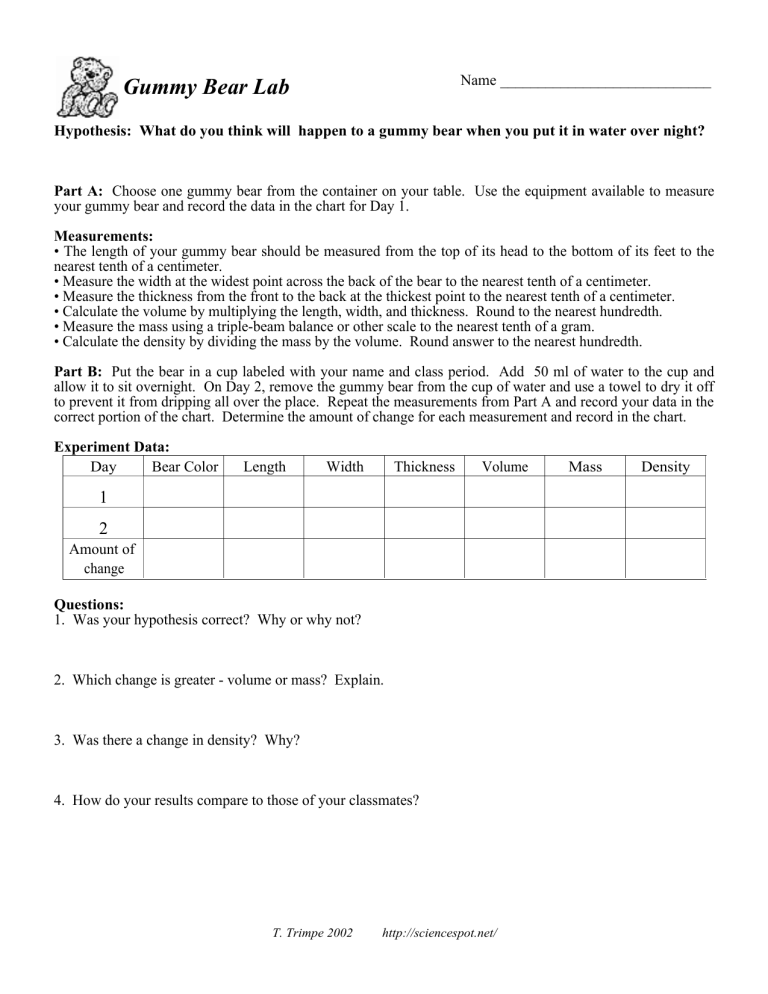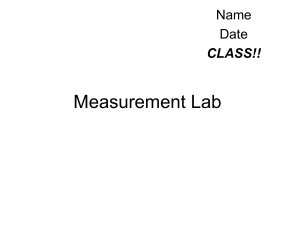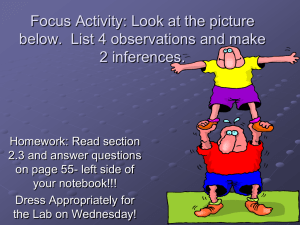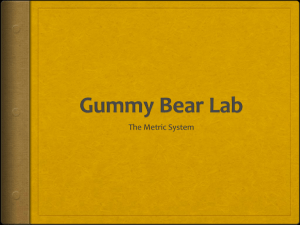
Name ____________________________ Gummy Bear Lab Hypothesis: What do you think will happen to a gummy bear when you put it in water over night? Part A: Choose one gummy bear from the container on your table. Use the equipment available to measure your gummy bear and record the data in the chart for Day 1. Measurements: • The length of your gummy bear should be measured from the top of its head to the bottom of its feet to the nearest tenth of a centimeter. • Measure the width at the widest point across the back of the bear to the nearest tenth of a centimeter. • Measure the thickness from the front to the back at the thickest point to the nearest tenth of a centimeter. • Calculate the volume by multiplying the length, width, and thickness. Round to the nearest hundredth. • Measure the mass using a triple-beam balance or other scale to the nearest tenth of a gram. • Calculate the density by dividing the mass by the volume. Round answer to the nearest hundredth. Part B: Put the bear in a cup labeled with your name and class period. Add 50 ml of water to the cup and allow it to sit overnight. On Day 2, remove the gummy bear from the cup of water and use a towel to dry it off to prevent it from dripping all over the place. Repeat the measurements from Part A and record your data in the correct portion of the chart. Determine the amount of change for each measurement and record in the chart. Experiment Data: Day Bear Color Length Width Thickness Volume 1 2 Amount of change Questions: 1. Was your hypothesis correct? Why or why not? 2. Which change is greater - volume or mass? Explain. 3. Was there a change in density? Why? 4. How do your results compare to those of your classmates? T. Trimpe 2002 http://sciencespot.net/ Mass Density Teacher Notes: This lab worksheet was created based on a gummy bear lab I found on the internet; however, the website with the original lab is no longer available. I use the lab during my Metric Mania unit when we are studying volume and mass. I did find another gummy bear lab that explores diffusion with gummy bears and describes the lab in terms of polymers. Go to http://www.psrc.usm.edu/macrog/proposal/dreyfus/outcome/gelatin/bearlab.html to view this lab and get ideas for extension lessons. Materials - Each student will need: 1 gummy bear (may want extra for the students to eat after they have completed the lab) 1 small cup of water (4 oz.) Measuring tools - metric ruler and scale Calculator (optional) 1 worksheet NOTE: I have had good luck with Brachs brand of gummy bears, but be sure to test your gummy bears before trying the lab with your students. Some gummy bears do not absorb water well as others. If you find some that don’t work for the lab, save them for treats after the lab! Extra time? Challenge your students to create an experiment with gummy bears. My students have asked if they will “grow” larger if left for another day. Others wondered if the temperature of the water had an effect on the rate of absorption. Some students wanted to experiment with colored water and other liquids to see what would happen to the gummy bears. Buy some extra and experiment! T. Trimpe 2002 http://sciencespot.net/



